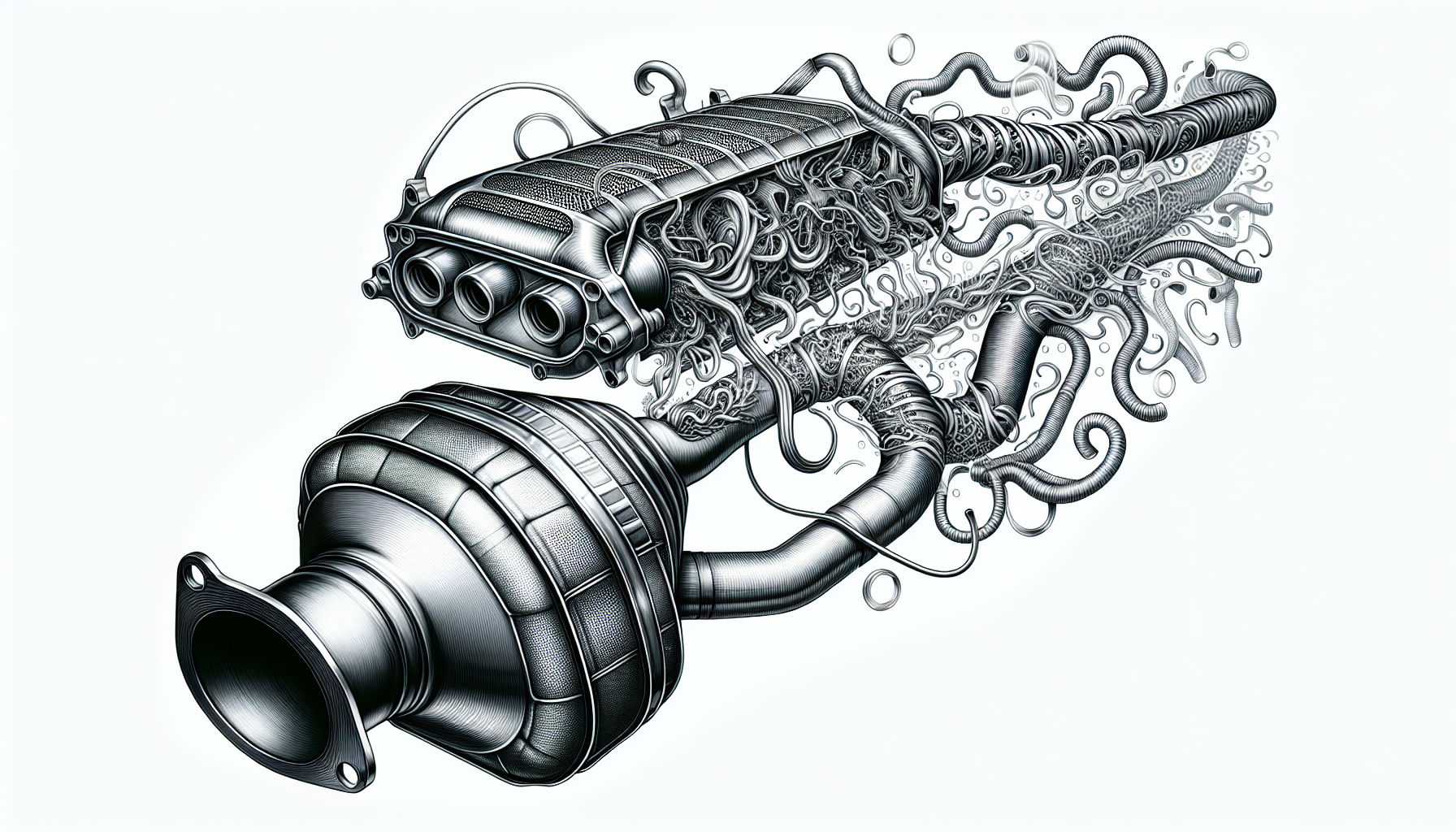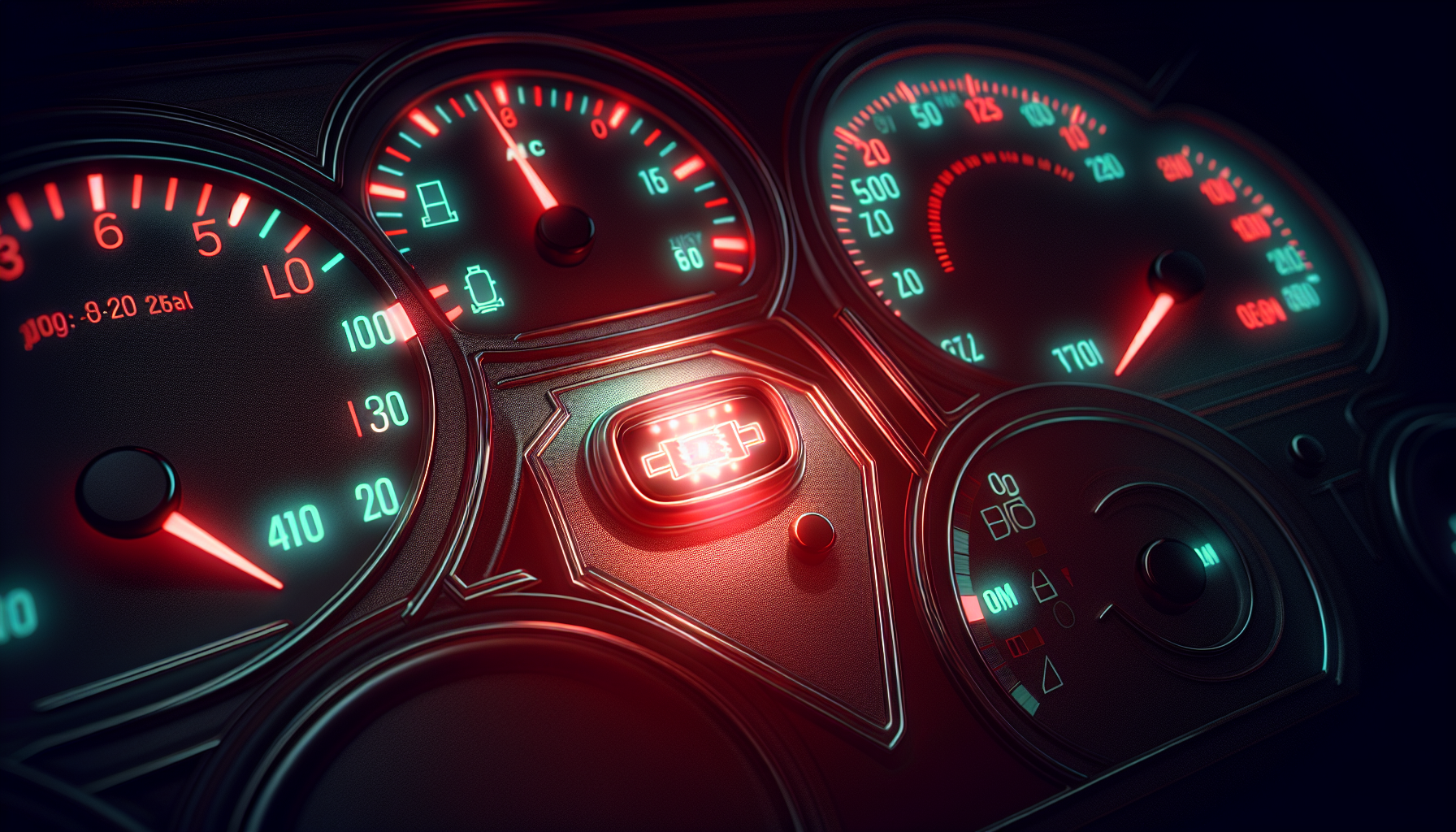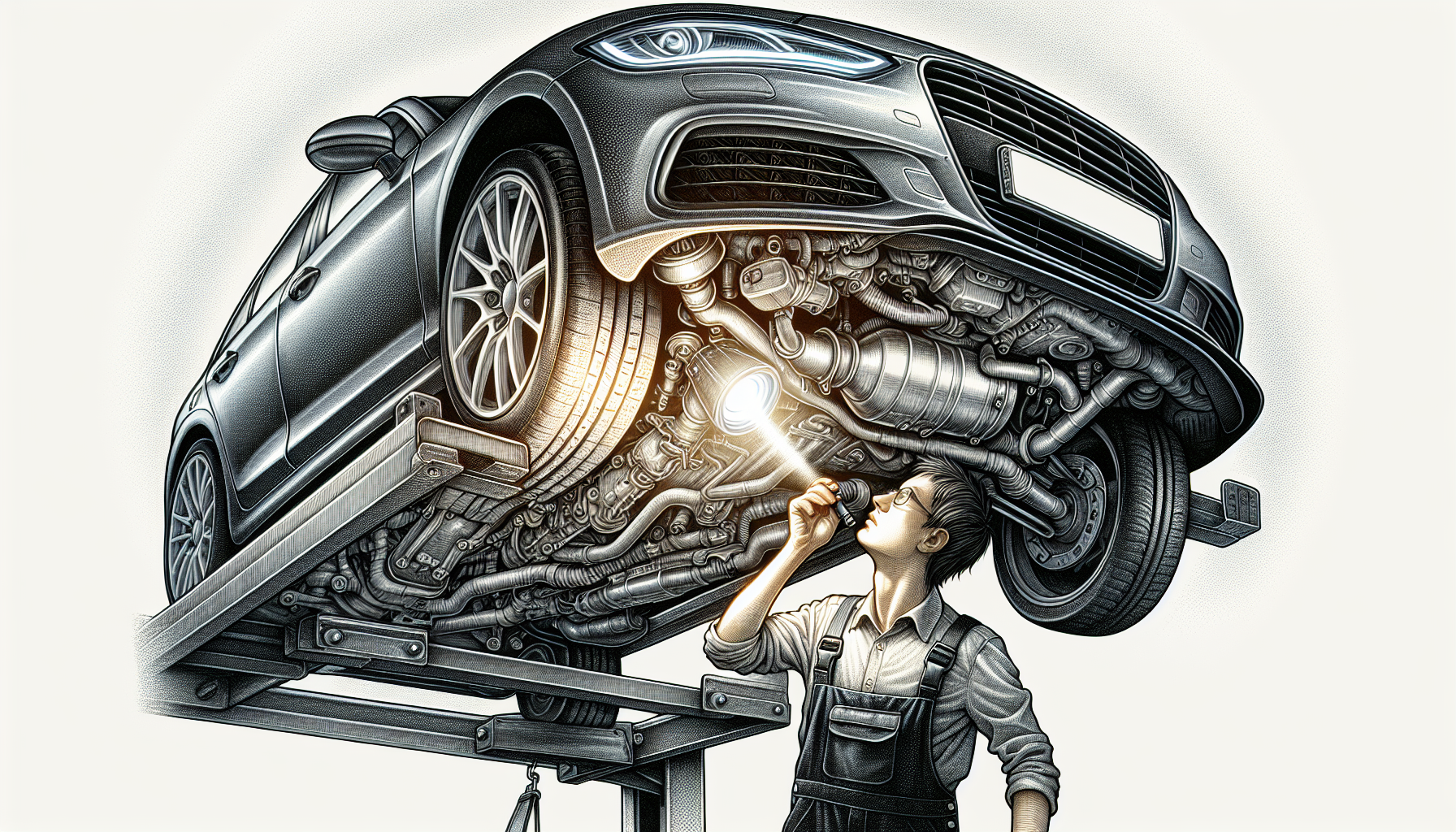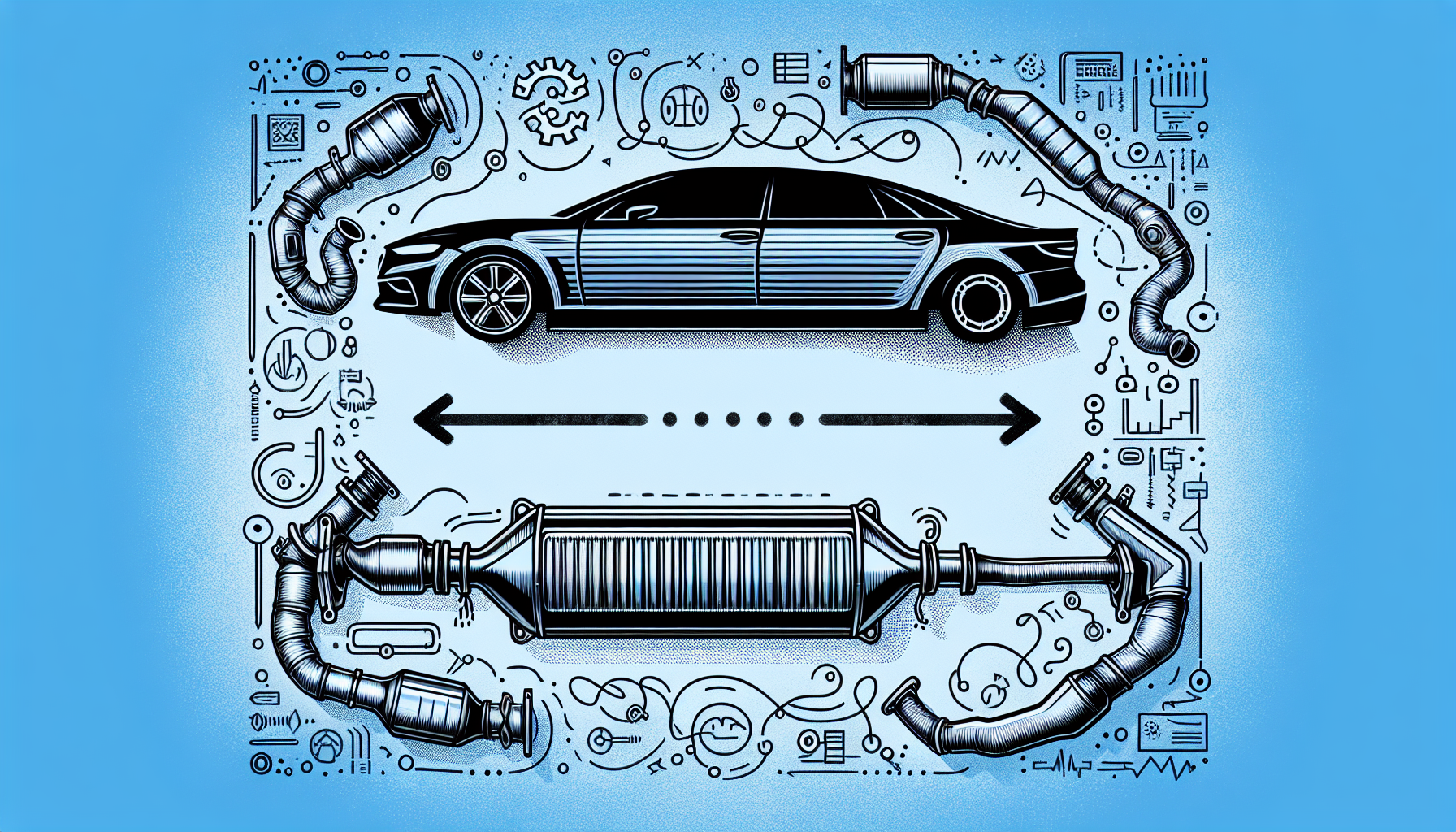Questioning whether to replace a catalytic converter can be a make-or-break decision for your vehicle’s health and your wallet. Is catalytic converter worth replacing? This article breaks down the crucial factors – from identifying a failing converter to understanding the financial implications of replacement. A no-frills guide awaits to navigate the complexities of this essential car component, ensuring your decision is informed, practical, and beneficial in the long run.
Key Takeaways
- The catalytic converter plays an essential role in reducing vehicle emissions and adhering to strict environmental regulations like the EURO 6 standard, making it a critical component for modern vehicles.
- Signs of a failing catalytic converter include difficulty starting the engine, poor acceleration, decreased fuel efficiency, check engine light activation, and rattling noises, which necessitate timely professional inspection and potentially costly replacements.
- The replacement of a catalytic converter is a significant financial consideration, influenced by factors such as the vehicle’s value, OEM versus aftermarket part costs, available warranties, and potential long-term benefits like improved emissions and resale value.
Understanding the Role of Your Catalytic Converter

A catalytic converter is more than just a piece of your car’s exhaust system. It plays a pivotal role in reducing vehicle emissions and contributing to a cleaner environment. In fact, it is so effective that the emissions of a single car from the 1960s would be equivalent to a staggering one hundred modern cars equipped with catalytic converters.
As the global community becomes increasingly aware of the need for environmental preservation, the role of the catalytic converter becomes even more vital. Modern emissions regulations, like the EURO 6 standard, demand significant reductions in pollutants, which further emphasizes the role of catalytic converters. Indeed, catalytic converters have been a game-changer in counteracting exhaust pollution, with regulations becoming increasingly stringent globally.
Signs That Your Catalytic Converter May Need Replacement

Knowing when your catalytic converter may need replacement is a crucial part of car maintenance. There are several tell-tale signs to look out for. These include difficulty in starting the engine, poor acceleration, and a decrease in fuel economy. If you notice any of these signs, it’s time to dive deeper and check for more specific indicators of potential catalytic converter failure.
Check Engine Light and Diagnostic Codes
An illuminated check engine light can be a preliminary warning sign of a potential catalytic converter problem. If you’re familiar with Diagnostic Trouble Codes (DTCs), you might notice codes specifically related to catalytic converter efficiency, commonly beginning with P042 or P043. It’s important to have specialized diagnostic tools to accurately read and interpret these codes.
Remember, whether it’s an Original Equipment Manufacturer (OEM) or an aftermarket part, catalytic converters can trigger diagnostic codes like P0420 when there are efficiency problems.
Decreased Fuel Efficiency and Engine Performance
Another red flag for potential catalytic converter failure is decreased fuel efficiency and engine performance. A clogged or faulty catalytic converter can create backpressure that hampers the engine’s operation, leading to:
- Reduced engine efficiency
- Sluggish vehicle response
- Reduced acceleration
- In severe cases, inability to start the engine
Driving with a malfunctioning converter can pose a safety hazard, causing engine misfires and energy loss during acceleration.
Rattling Noises from Under the Vehicle

Hearing rattling noises from under your vehicle? This could be a sign of a loose or damaged catalytic converter. Internal components within the catalytic converter, like the substrate, can degrade and cause a rattling sound. A rattling catalytic converter often signifies its end of life, requiring attention or replacement.
If you ignore these noises, it can lead to further degradation of the catalytic converter, potentially resulting in an expensive replacement. It’s advisable to have a professional mechanic inspect the vehicle to determine if the cause of the rattling is due to a catalytic converter issue or another problem.
Assessing the Cost-Benefit of Replacing Your Catalytic Converter
Now that you’re familiar with the signs of a failing catalytic converter, let’s delve into the financial aspect of replacing it. It’s important to understand that the cost of a new catalytic converter varies between $500 and $2200, so it’s a significant financial decision. What’s more, ancillary expenses such as car rental needs and the possible decline in the vehicle’s value post-repair should also be factored in.
Let’s explore this further.
Comparison of Replacement Costs Versus Vehicle Value
When deciding whether or not to replace your catalytic converter, you should consider the following factors:
- The vehicle’s age
- The vehicle’s current market value
- The replacement cost
- OEM versus aftermarket costs
- Potential for additional repairs
By comparing these factors, you can make an informed decision about whether or not to replace your catalytic converter.
For example, for a flooded car with flood damage, the cost of repairs may exceed the price of purchasing a new vehicle. Therefore, it’s important to analyze these factors carefully.
Impact on Auto Loan and Monthly Financial Commitments
Financing a catalytic converter replacement can affect your monthly financial commitments. This impact is influenced by factors such as the duration of the loan, the vehicle’s worth, and the longevity of the repair. It’s crucial to take into consideration your personal financial situation and evaluate the potential impact on your monthly loan payments when deciding on the best method of financing the replacement.
Long-Term Benefits Versus Immediate Expenses
It’s also essential to balance the immediate expense of replacing your catalytic converter with its long-term benefits. These benefits may include improved emissions, adherence to legal standards, and the potential for increased resale value of the vehicle.
Although paying cash for the replacement avoids incurring interest charges, it requires sufficient funds, which might be needed for other pressing financial obligations. The decision to replace a catalytic converter should be made after careful consideration of these factors, including whether to pay cash or opt for another payment method.
Options for Catalytic Converter Replacement
Having weighed the pros and cons of replacing a catalytic converter, if you decide to go ahead with it, you have several options at your disposal. Whether it’s deciding on the type of part to use or choosing a trustworthy repair shop, each decision can influence the overall cost of the replacement.
Choosing Between OEM and Aftermarket Parts

The first big decision you’ll need to make is whether to choose Original Equipment Manufacturer (OEM) or aftermarket parts. OEM catalytic converters are specifically made to fit individual vehicle models, ensuring compatibility without requiring adjustments. They are designed to meet strict emissions regulations and endure extended use, contributing to their higher quality and durability compared to aftermarket options.
On the other hand, aftermarket catalytic converters have the following characteristics:
- They are typically more affordable
- They can vary significantly in terms of fit, performance, and longevity
- Some aftermarket catalytic converters come with warranties
- They may contain fewer precious metals, affecting their performance and their ability to effectively filter engine emissions
Therefore, it’s crucial to weigh the benefits and drawbacks of both options when deciding on the best choice for your vehicle during the car shopping process.
Finding a Trustworthy Repair Shop or Dealership
Once you’ve chosen the type of part, the next step is to find a trustworthy repair shop or dealership. Factors to consider include:
- The shop’s reputation
- Industry certifications
- Affiliations with professional organizations
- Proven experience dealing with your specific type of vehicle
Reading online customer reviews can provide insight into the experience others have had with the repair shop and the success of their catalytic converter replacements.
Lastly, inquire about the shop’s warranties and guarantees on their work to ensure that you will be covered in case of any post-replacement issues.
Understanding Warranty and Coverage Options
Understanding your warranty and coverage options is also crucial when replacing your catalytic converter. The Federal Emissions Warranty mandates that manufacturers must cover catalytic converters for at least 5 to 8 years or 80,000 to 100,000 miles, and any defective parts must be replaced within this period at no cost. Some states provide extended warranties on emission-related parts, offering additional coverage that surpasses federal requirements.
The coverage offered by aftermarket catalytic converter warranties can vary significantly, so it’s important to check if they meet Environmental Protection Agency standards and offer sufficient protection in terms of duration and mileage. Vehicle owners can also opt for extended warranties from either the manufacturers or third-party providers to lengthen the coverage time of their catalytic converters beyond the original terms. Some auto parts retailers even offer lifetime warranties on catalytic converters, which can provide long-term savings and reassurance.
The Risks of Driving With a Faulty Catalytic Converter

While it’s important to weigh the cost and benefits of replacing a catalytic converter, it’s equally crucial to be aware of the risks associated with driving a vehicle with a faulty one. Driving a vehicle with a faulty catalytic converter can pose safety risks, including the potential for the car to break down or even catch fire.
Let’s delve deeper into these risks.
Legal and Environmental Consequences
Driving with a malfunctioning catalytic converter can lead to both legal and environmental consequences. You could face the following consequences:
- Fines
- Legal penalties
- Vehicle impoundment for violation of emissions regulations
- A vehicle without a catalytic converter may emit higher levels of noise, possibly breaching local noise ordinances, which can also result in fines.
On the environmental front, driving without a catalytic converter can cause significant environmental harm, contributing to air pollution due to the unrestrained release of toxic gases. Moreover, in states with strict emissions standards, not using an approved CARB-compliant catalytic converter leads to non-compliance with local laws.
Potential for Additional Vehicle Damage
A faulty catalytic converter can also lead to additional vehicle damage. Some examples include:
- Internal cooling system leaks can poison the catalytic converter, causing it to fail.
- Catalytic converter failure can result from internal contamination such as unburned fuel or engine oil entering the exhaust system.
- Physical damage from road debris, collisions, or other impacts can also affect the catalytic converter.
Moreover, removal or damage to the catalytic converter can increase exhaust temperatures, causing further damage to exhaust system components. Ignoring a faulty catalytic converter can lead to damage to the oxygen sensors and exacerbate issues within the overall exhaust system of the vehicle.
Safety Risks While Operating the Vehicle
More than anything, your safety should be the top priority. Fumes from a defective catalytic converter entering the vehicle cabin can pose a significant safety risk to its occupants. If a catalytic converter is bypassed or missing, exhaust gases can be emitted directly under the vehicle, increasing the likelihood of these harmful gases entering the passenger compartment. This can lead to symptoms such as nausea and light-headedness among the vehicle’s occupants.
Lastly, a failed catalytic converter can contribute to engine overheating, which, particularly when traveling long distances, elevates the risk of a vehicle fire.
How to Get the Best Deal on Catalytic Converter Replacement
Now that you understand the risks of driving with a faulty catalytic converter, let’s explore how you can get the best deal on its replacement. The cost of a new catalytic converter can be significant, so it pays to know how to negotiate the best deal and find the most affordable options.
Researching for Competitive Pricing
One of the best ways to secure a great deal is by researching competitive pricing for catalytic converter replacements. Here are some tips to help you find the best prices:
- Compare prices from multiple sources, such as online retailers and local auto part shops.
- Consider independent repair shops, as they often offer more competitive pricing compared to dealerships.
- Look for any ongoing promotions or discounts that may be available.
By following these tips, you can find the best prices for catalytic converter replacements and save money.
Exploring financial solutions such as insurance coverage for theft, considering low-cost universal or aftermarket converters, and seeking out subsidies or assistance programs can significantly reduce the financial burden of replacing a catalytic converter.
Leveraging Incentives and Discounts
In addition to comparing prices, leveraging incentives and discounts can also help reduce replacement costs. You might want to consider alternatives like public transportation, carpooling, or seeking community funding through platforms like GoFundMe to mitigate the immediate financial burden of replacing a stolen catalytic converter. Sourcing used catalytic converters from salvaged vehicles can provide a cost-saving measure and meet the required specifications for replacement. Furthermore, universal catalytic converters available at muffler shops can offer a less expensive alternative to specific aftermarket parts sold online.
Automaker incentives, including cashback offers and special financing, can reduce the cost of catalytic converter replacements, though availability may be limited to certain models or inventory.
Effective Negotiation Strategies with Service Providers
Negotiation is a key part of securing the best deal at car dealerships. Obtaining multiple estimates, including those from trusted independent garages, and comparing these to dealership quotes can help leverage the best deal for catalytic converter replacements. Sourcing a catalytic converter independently before seeking a service provider for installation has been a successful strategy for some customers to negotiate lower service rates.
Remember, negotiation should be focused on the full cost of services rather than monthly payments. Don’t be afraid to walk away from a deal that does not meet your financial terms, as it might not be a good deal.
Financing Your Catalytic Converter Replacement
If paying for a catalytic converter replacement upfront is not feasible, you might need to consider financing options. Various payment methods for car repairs include:
- Using cash
- Borrowing from friends or family
- Paying with credit cards
- Obtaining a personal loan
It’s essential to understand the implications of each of these options on your overall financial health.
Evaluating Loan Versus Out-of-Pocket Payment
When considering financing options, it’s important to evaluate the pros and cons of loan versus out-of-pocket payment for replacement. Opting for a loan may have lower upfront costs than out-of-pocket payment, but it could lead to higher overall expenses due to interest charges. On the other hand, out-of-pocket payments avoid interest but require sufficient savings, which may not be accessible to all vehicle owners. Interest rates on loans can significantly increase the total cost of a catalytic converter replacement over time, making this option less economical.
Monthly repayments for financing a catalytic converter can affect personal cash flow, which necessitates careful budgeting to ensure ongoing financial health. One option to consider is using a cashier’s check for the initial payment, or a wire transfer, to avoid potential complications.
Considering Credit Building Opportunities with Financing
Financing a catalytic converter replacement can also provide opportunities to build your credit. Here’s how:
- Obtaining a personal loan for car repairs might temporarily lower your credit score due to increased debt levels.
- However, paying off a personal loan on time reflects responsible credit management.
- This can have a positive impact on your credit score over time.
Credit rating agencies take into account factors like payment history and diversification of credit types, which are influenced by personal loans and personal check usage, thus affecting the overall credit score and helping to build credit.
Understanding Interest Rates and Repayment Terms
Lastly, it’s crucial to understand the interest rates and repayment terms for financing options. Here are some key points to consider:
- The interest rate for personal loans varies based on the borrower’s credit score, where higher credit scores usually secure lower interest rates.
- Credit cards offer quick funding for car repairs but may entail higher interest costs compared to personal loans.
- Personal loans offer more structured repayment plans but come with minimum borrowing limits and require a pre-agreed loan amount.
It’s also worth noting that Annual Percentage Rates (APRs) for auto repair loans may be higher than the base interest rate due to the inclusion of additional fees like origination fees.
Preventative Maintenance to Prolong Catalytic Converter Life
To avoid the hefty cost of replacing a catalytic converter, it’s important to focus on preventative maintenance. Regular maintenance of a catalytic converter is crucial for optimal performance and to extend its lifespan. Let’s explore how you can ensure the longevity of your catalytic converter through routine vehicle check-ups, recognizing early warning signs, and keeping up with the manufacturer’s maintenance schedule.
Routine Vehicle Check-Ups and Diagnostics
Regular inspections of the exhaust system, including the catalytic converter, are crucial for early detection and resolution of potential issues. Regular vehicle maintenance such as oil and filter changes, using higher-quality gasoline, and avoiding low-speed driving periods can extend the life of a catalytic converter. Following the vehicle manufacturer’s recommended maintenance schedule is essential to avoid damage to the catalytic converter.
Updating the powertrain control module with the latest software from the vehicle’s manufacturer can resolve certain emissions-related problems. The proper operation of the powertrain control module is vital for maintaining the air/fuel ratio, with any significant deviations in fuel trim readings potentially signaling issues that could harm the catalytic converter.
Recognizing Early Warning Signs
Being vigilant for early warning signs of a failing catalytic converter can save you from costly repairs down the line. Rattling noises coming from under the vehicle may signal the breakdown of the catalytic converter’s ceramic structure, leading to exhaust blockages. Driving with a damaged catalytic converter can lead to inhalation of unhealthy fumes, posing health risks to the driver.
Early identification of a failing catalytic converter during an inspection can help prevent more extensive and expensive damage to the vehicle.
Keeping Up with Manufacturer’s Maintenance Schedule
Finally, keeping up with your vehicle manufacturer’s recommended maintenance practices is crucial for extending the life of a catalytic converter and ensuring optimal vehicle performance. This includes regular oil changes and service check-ups to prevent physical damage to the catalytic converter and to ensure its efficient performance.
Making an Informed Decision: To Replace or Not?
After weighing the costs, benefits, and risks associated with replacing a catalytic converter, you might be wondering: should I replace it or not? It’s a complex decision that requires careful consideration.
Evaluating the cost-effectiveness of replacing a catalytic converter involves assessing the price of the part, the labor costs for installation, and the overall value of the car. If the cost of a new catalytic converter approaches or surpasses the value of the vehicle, it may be more cost-effective to invest in a new car.
On the other hand, new catalytic converters are recommended over second-hand options due to safety concerns and potentially greater reliability and lifespan.
Summary
To sum up, a catalytic converter is an essential component of your vehicle, playing a crucial role in reducing harmful emissions and contributing to a cleaner environment. Recognizing early signs of a failing catalytic converter, understanding your replacement options, and performing regular vehicle maintenance can help you avoid costly repairs and ensure your car’s optimal performance. Whether you decide to replace your catalytic converter or not, make sure it’s an informed decision that takes into account all the factors discussed in this blog post.
Frequently Asked Questions
What is the role of a catalytic converter in a vehicle?
The role of a catalytic converter in a vehicle is to reduce over 90% of harmful emissions by transforming them into less harmful substances, such as carbon dioxide, nitrogen, and water vapor.
How can I tell if my catalytic converter needs replacement?
If you experience difficulty in starting the engine, poor acceleration, decreased fuel efficiency, rattling noises from under the vehicle, and an illuminated check engine light, then it’s likely that your catalytic converter needs replacement.
What are the risks of driving with a faulty catalytic converter?
Driving with a faulty catalytic converter can pose safety risks such as car breakdown or fire, and can lead to legal and environmental consequences due to emissions regulation violation. It’s important to address any catalytic converter issues promptly.
How can I get the best deal on catalytic converter replacement?
To get the best deal on catalytic converter replacement, research competitive pricing, leverage incentives and discounts, and negotiate effectively with service providers. This will help you save on the cost of replacement.
What preventative maintenance measures can I take to prolong the life of my catalytic converter?
To prolong the life of your catalytic converter, it is crucial to prioritize regular vehicle check-ups and diagnostics, recognize early warning signs of a failing converter, and adhere to the manufacturer’s maintenance schedule. These measures can significantly extend the lifespan of your catalytic converter.
For more information, visit https://www.carmula.com/





 Who We Are
Who We Are Coverage Area
Coverage Area Donate
Donate